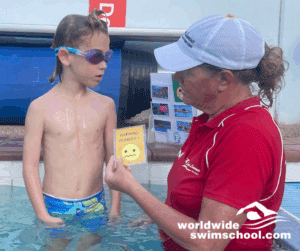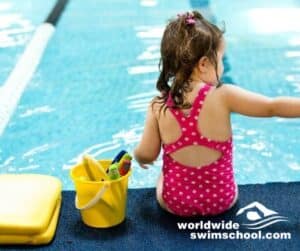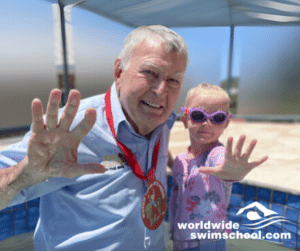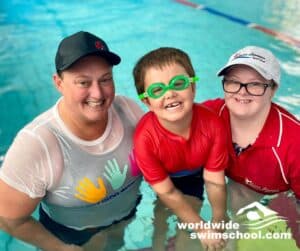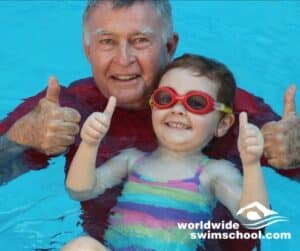Laurie grew up around the famous Tobruk pool where great Olympians trained. These early experiences as a child, along with his formal education, helped to develop his philosophies around effective teaching practices. Laurie was aware early on that the need for great Swim Teachers around him would help his swim school grow.
Over the past 40 years, Laurie has trained his swimming teachers to call upon certain “Teaching tools” to help them become great Swim Teachers. This article explores several teaching tools that Laurie believes makes great Swim Teachers. In particular, lesson plans, simple instructions, visual demonstrations and continuous positive feedback.
Teaching Tool 1: Lesson Planning
Swim Teachers have hundreds of children who they are responsible for each week. Lesson plans are vital to ensure teachers meet the individual needs of swimmers in their groups. It encourages effective teaching because it sets clear goals and objectives.
Swim Teachers develop a set program for the class which will be delivered over a set swimming term. Importantly this program will need constant review and reflection depending on the swimmers progress or dynamics of the group. Laurie encourages teachers to review lesson plans and make adjustments where necessary. This is also a good time for self-reflection and identifying problem areas.
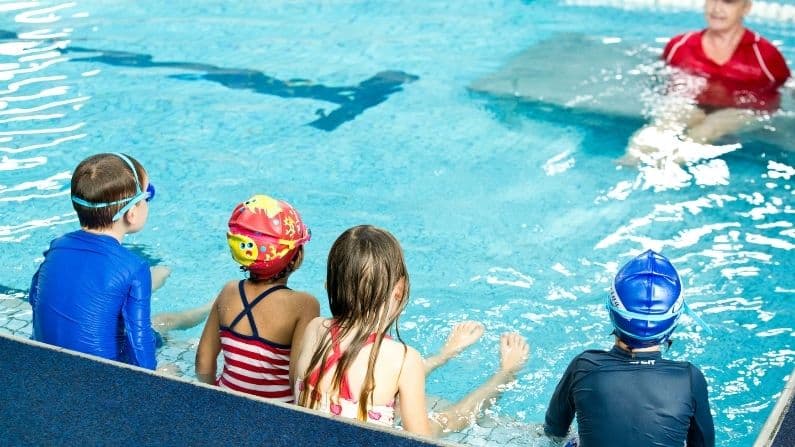
Teaching Tool 2: Simple Instructions
Swim Teachers must use simple instructions to enable children to understand a complex action in a clear and simple manner. This allows for enhanced understanding, ease of memory recall, and time saving during explanation.
It's important to have key words that will remind swimmers of what they should be focusing on. For example, freestyle teachers will tell swimmers, “chin on your chest, fast little kicks, high elbows”. Similarly, in backstroke they will be saying “head back, tummy up, knees underwater”.
The use of simple instructions is also important in classes where the parent is in attendance. It is very easy for parents to become distracted and overwhelmed by pool environment.
Teaching Tool: 3 Visual Demonstrations
It is important to remember that people learn in different ways, either by auditory, visual or kinaesthetic learning styles. For this reason, it is important that verbal instructions are always followed with a visual demonstration before children are given a chance to practice.
Show children what you want, let them practice and repeat until the skill is mastered. Swim Teachers can also use other visual cues like hand signals and facial expressions to assist in class control and behaviour management.
For example, teachers may use their hands to signal children to move over or strop or simply give a thumbs up for a job well done. Similarly in teaching parent and baby classes visual demonstrations and cues remain very important.
Teachers can also use other visual cues like hand signals and facial expressions to assist in class control and behaviour management
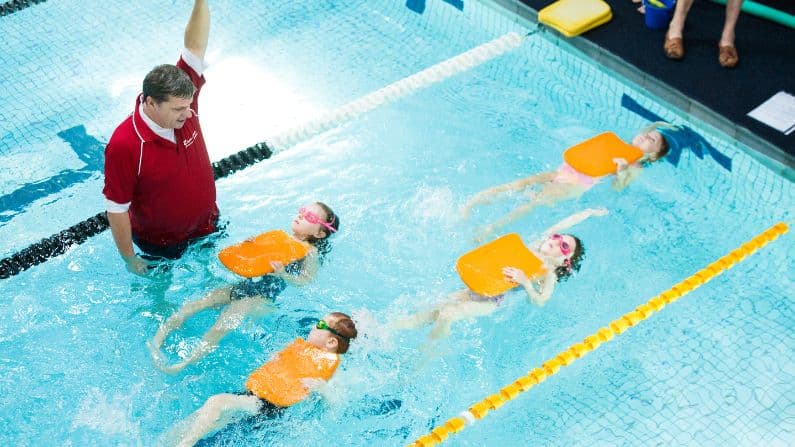
Teaching Tool 4: Maximum Practice Time
Maximum practice time in the class is essential for faster acquisition of swimming skills. Therefore, Swim Teachers must ensure children are grouped homogenously by ability level. Classes should also be conducted in suitable environments so teachers don't have to teach kids one at a time.
For example, using shallow water for non-swimmers or beginners, where they can stand independently, is recommended. In classes for children under the age of 4, Laurie insists on parental involvement. In doing so, all children receive one on one attention and maximum practice time in the lesson is achieved.
It is important that children learn how to circle the lane and move over during their first few swimming lessons. Children will need constant reminders about this expectation. However, if the idea is instilled from an early age, it is much easier for the teacher.
Teaching Tool 5: Class Control
Disruptive student behaviour is a threat to learning, especially in the learn to swim environment where teachers have a small window of time to teach. Swim Teachers must maintain class control to ensure the safety of their class at all times.
They must always establish class focus and ensure they have all participants attention before they commence instructions. Teachers can avoid boredom in their students by being simple and clear with their instructions.
Laurie always encourages teachers to place themselves in a position of strength. For example, using a semi-circle formation while giving directions to a group will ensure that all students and parents can see and hear the information.
Teaching Tool 6: Positive Reinforcements
Using positive language and putting emphasis on what you want, rather than what you don’t want, is recommended. Laurie always insists that teachers acknowledge good work and set an expectation of excellence in swimming classes.
It is vital that Swim Teachers are fair and consistent. Therefore, rules and expectations should be established with the class. If students do not follow class rules, teachers should then follow through with consequences. But make sure parents and students understand the class rules and what the consequences are for inappropriate behaviour.
Swim Teachers should avoid getting angry, yell or use unnecessary threats. Instead, be alert and move around the group and praise good behaviour. Utilising reward systems like merit stickers or certificates are also excellent.
Laurie always insists that teachers acknowledge good work and set an expectation of excellence in swimming classes
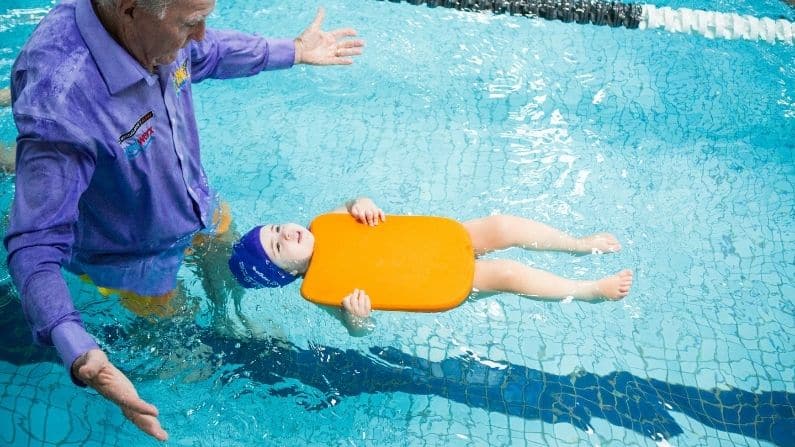
Teaching Tool 7: Identifying Students By Name
Using the names of students and parents helps to create a more personal teaching environment. Having a good relationship with your students helps to relax students and builds their trust. This trust is particularly important with frightened beginners or new parents who are introducing their baby to the aquatic environment for the first time.
Knowing the students names will also help to establish student focus as Swim Teachers can simply remind individual students to look at them if necessary. It also helps to maintain maximum practice time as teachers can ask students by name to get ready and go.
Furthermore a class role where teachers can mark students present or absent is also important to ensure the safety of students in their class.
Teaching Tool 8: Voice Control
Laurie always encourages teachers to have light and shade in their voice and use it like a musical instrument. By varying the tone, pitch and volume in your voice you can engage your students.
Swim Teachers should avoid yelling and screaming as this can be disruptive to other instructors. Teachers should try to speak at a level that is sufficient enough for all their students to hear while speaking clearly and avoiding the use of slang.
Combining hand signals, facial expressions and body language with the expression in your voice will help teachers to communicate effectively with their students.
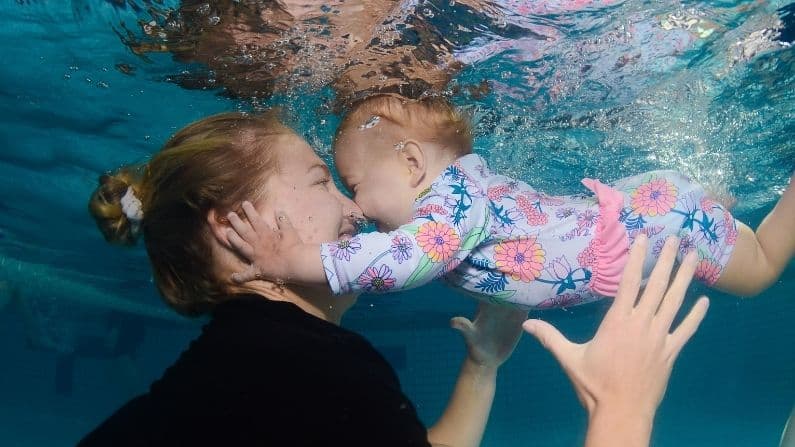
Teaching Tool 9: Eye Contact
Using eye contact will help when teachers want to communicate with individuals in their class. Again this engages the learner as they know that the message the Swim Teachers are trying to communicate is directly for them. Getting eye contact with all students prior to communicating to the group will also ensure students are ready to listen.
Eye contact can also be helpful in building relationships and making parents and children feel relaxed. Babies and toddlers also enjoy establishing eye contact with their parents. This is a way for parents and babies to communicate with one another even before language is developed.
It is important to note that in some cultures or with certain personality type’s eye contact can be intimidating or uncomfortable for people and teachers may need to use their discretion.
Teachers should try to speak at a level that is sufficient enough for all their students to hear while speaking clearly and avoiding the use of slang
Teaching Tool 10: Maintaining Enthusiasm
Teachers should be enthusiastic as this will set the tone of the class. Being enthusiastic will also create a stimulating and enjoyable learning environment for the class. Swim Teachers should always remember to smile and have fun. This will make the environment inviting for children and parents.
It is the teachers responsibly to create a positive learning environment where swimmers feel comfortable to learn at their own pace. The teacher may also need to motivate the group to keep going or put challenges in place to keep the class interesting.
They must learn to give full attention to the task at hand and not be distracted by outside influences. If you give 100% of yourself to your class you we get the same in return.
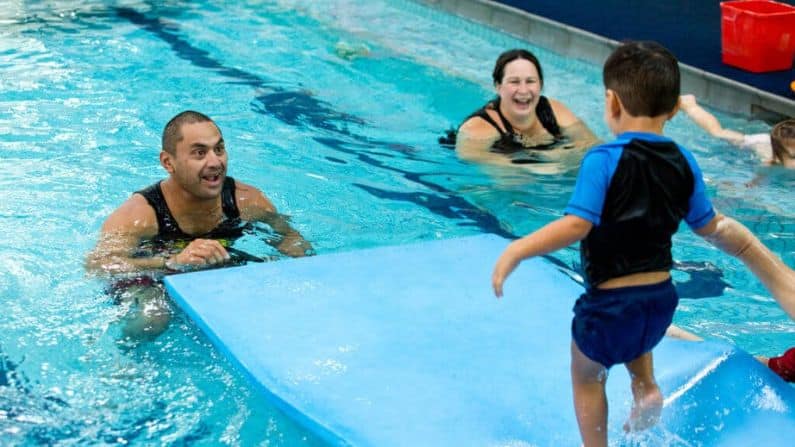
Teaching Tool 11: Continual Positive Feedback
Laurie always insists that teachers are genuine and specific with feedback as it is an essential part of learning. However, it should always be done in a positive way. Teachers should avoid simply saying good boy or good girl but rather give students specific details.
For example, say “what a champion - you had fast little kicks”. It is important for muscle memory that incorrect skills are corrected as soon as they happen. However students should never be made to feel inadequate or silly for their attempts.
Swim Teachers can provide feedback individually or to the group as a whole. This feedback can be done verbally, visually or physically. Remember parents also love positive feedback on their child’s progress and things that they can do at home to help improve on swimming skills.
Conclusion
In conclusion, there are many tools that a teacher can call upon to be an effective teacher. Laurie encourages you to:
- Regularly review your teaching performance
- Try to be enthusiastic
- Plan the lesson
- Demonstrate skills and drills
- Teach one skill at a time
- Identify children by name
- Involve all children in the activity
- Keep instructions simple
- Maintain eye contact
- Use your voice well
- Provide instant positive feedback
- Maintain good class control
- Encourage maximum practice time during your lessons
Join our community and keep up to date with new articles, special offers - it is free to join!
Looking for more information on learning how to swim - don't go past the Swim Library.

